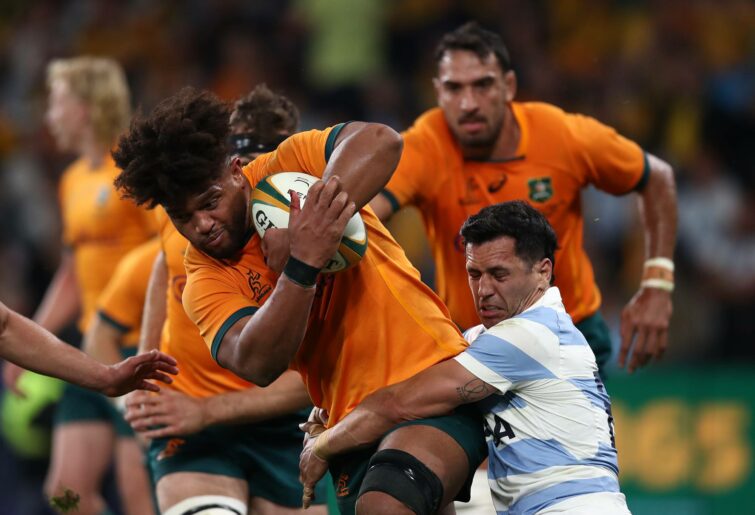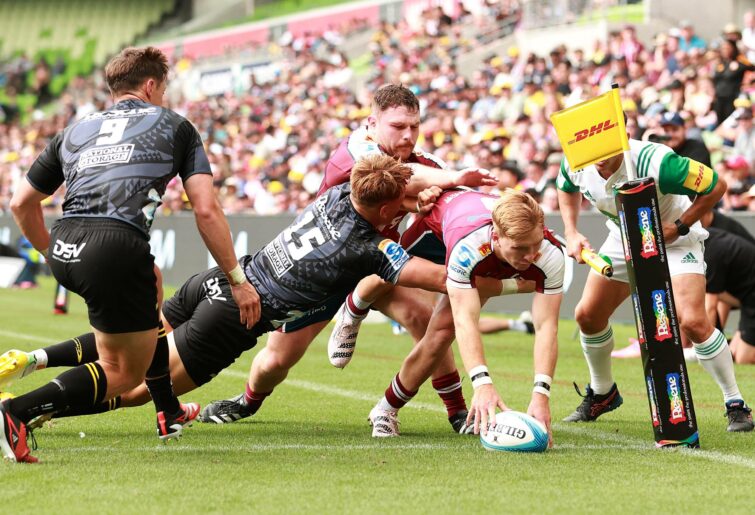'Run-on debut like no other': Junior Wallabies flyer announces himself to the world after stunning hat-trick
In 15 minutes, Tim Ryan didn’t just put a smile on Joe Schmidt’s face, he announced himself to the Australian public by scoring a…
I have seen every Test the Wallabies have played since 1972, but due to a combination of work, family and living in the bush all were seen on TV. Until last year, when I went to two Tests in Sydney. Regardless of the result – the Wallabies lost both games – I was disappointed with the live rugby offering. It took two hours to get into the ground with the queues. The food was terrible. Entertainment and compering were unsophisticated and crass and any attempts to stir up some excitement with a Cadbury’s shout-o-meter were met with limited response.
In short, the atmosphere was lacking. When watching on the telly, you aren’t as aware of the time the ball is not in play, taking the opportunity to go to the loo or fridge.
When the game finally got started it was boring, with excessive stoppages, unreadable penalties and few episodes of open attacking play. Scrums and lineouts are not platforms for ball-in-hand attack but ways set to force even more penalties.

Rob Valetini. (Photo by Jason McCawley/Getty Images)
The football market in Australia is saturated, characterised for the most part in the NRL, AFL and soccer by space, open play, ball movement and flow. While rugby league is perhaps one-dimensional, there is no game plan to force a penalty by an opposing side.
Watch every match of Super Rugby Pacific ad-free, live & on demand on the Home of Rugby, Stan Sport
If the conversation about rugby is to shift from what is happening off the field to what is happening on the field then we need to change what is happening on the field. I am suggesting some leveraged changes to the rules to create a unique Australian brand of rugby, that removes some of the frustrating aspects for the fan and puts the emphasis on flowing play, attack and reward for skill, not simply phase after phase of pick and drive.
Restrict all long-arm penalties to dangerous or overtly cynical play or repeated offences. The aim is to reduce the number of time-sapping, long-arm penalties per game by at least 30 per cent and preferably 50 per cent. For all other rule infringements give a short arm penalty (or free kick), subject to the conditions below.
For both long-arm penalties and free kicks, mandate that the defending (offending) team must immediately retreat ten metres and not advance or be involved in the play until the ball has crossed that ten-metre line, or another infringement or stoppage occurs (such as a knock-on the by the attacking team). The aim is to encourage greater use of the quick tap while providing space to set up an attack.

Tate McDermott scores a try. (Photo by Kelly Defina/Getty Images)
Where a long-arm or short-arm infringement occurs ten metres or less from the goal line, the defending team must retreat with at least one of the defending players’ feet firmly planted behind the goal line and cannot advance until, if a quick tap is taken, the first pass is made by the attacking team.
In addition, where advantage is being played after a penalty, the offending player(s) shall be nominated by the referee on the run and required to retreat immediately twenty metres or behind the dead-ball line and not be involved in the play again, until another stoppage occurs (mini sin bin). This rule would aim to reward attacking teams and provide greater punishment for frustrating cynical play and repeated infringements on the defending goal line.
If a penalty advantage is given in the opposition 20 metres, and the offending player does not comply and involves themselves further in the play then a penalty try shall be immediately given and the player further sanctioned with a ten-minute yellow card sin bin or red card send off if the offence warrants this sanction. Double jeopardy would also apply. A player retreating behind the dead-ball line could still be subject to greater sanction when play stops.
For a short-arm penalty, the option to kick out on the full would have the normal rules apply as for a kick over the sideline in general play. The aim is to encourage a quick tap.
In addition give the attacking team, after a long-arm penalty is given, the option to take a line out on the line of the penalty, avoiding another kick the ball out time waster, particularly when a penalty is given close to the goal line when kicks are made in to touch with sometimes minimal or no metre gain simply to establish an attacking line out and a maul.
Also, allow a scrum option for a penalty to be set anywhere on the line of the penalty to encourage more set attacking play variety when a long-arm penalty is given.
These changes would address one of the key frustrations with rugby, the penalty. They would improve flow and encourage ball in hand, reduce stoppage time and promote set piece innovation. If we want the discussion to be about what happens on the field then we need to influence what happens there and not just hope that the popularity of the rugby game in Australia solely depends on a return to winning.